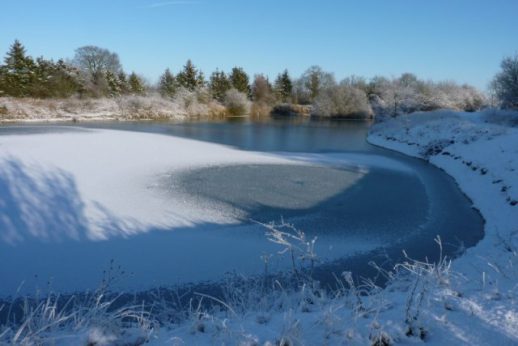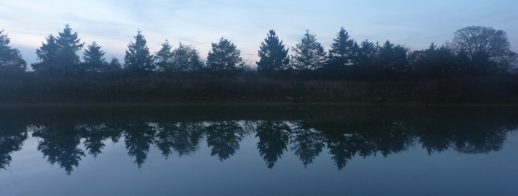Yalda Davis returns childhood relics to the reservoir she has known all her life

One of my many enjoyments at the reservoir is watching how the colour of the water changes according to the weather and the seasons: in the summer sunshine it is grey-green or blue. In winter it is usually murky brown or grey. It is not a regular shape, as so many other reservoirs are, which makes it more attractive. It is fifteen or twenty metres across its narrowest point – which used to be a walkway between two smaller reservoirs that were turned into one large one – and at least four times that in length. Along two sides it has a row of conifers interspersed with hawthorns, and on the others are a mixture of hawthorn, blackthorn, dog rose, willow, elder and brambles, with an area of rough grass and scrubby woodland behind it, containing the hidden ruins of the barn and several small ponds with bullrushes. Even though the brick foundations are less mysterious to me now I know they belonged to the barn, they are almost as intriguing as they always were, as I still cannot imagine the reason for constructing anything in this manner that you would wish to stay standing for long.
A crop of early purple orchids appears in spring every year. I enjoy coming to pick elderflowers here, and blackberries in autumn. This year I intend to collect rosehips too, if I can only catch the right moment to harvest them – the last two years I have failed in this endeavour and they have turned seemingly instantly from stone-hard fruits to rotten mush. I have tried haws but concluded they have an unpleasant texture and no taste to speak of, and would not be worth the trouble of including in jellies.
The vegetated little island at one end of the reservoir is a favourite nesting site of ducks and geese, and yellow flag irises grow at the edge of the water behind it. A dead tree to one side that must have fallen off the island into the water now resembles driftwood. On my first outing in an inflatable kayak I’d just bought, I saw a kingfisher take off from its top end, which leans on the bank – my only kingfisher sighting so far at the reservoir, having only a few hours earlier met someone walking there, who remarked that a kingfisher perching on the dead branch would make the perfect scene.
*
I sometimes wonder that the reservoir doesn’t attract so many water birds as other, mostly man-made, bodies of water in the area: I can only think that perhaps its steep sides, depth and the absence of algae make it less suitable for dabbling ducks. Apart from the usual mallards, visitors include Canada geese, greylag geese and once a pair of pintail ducks – the last is an unusual sighting for this area.

A pair of Canada geese nests every year on the island, and this year they raised eleven goslings, which is more than double the number they usually hatch. Although the clues were all there, and I had noticed a few odd details through the season, I did not join the dots and therefore forgot all about them until the subject arose when I passed my neighbours on the footpath a month or two after the family’s departure: strangely, several of the goslings did not resemble their siblings or their parents.
I was intrigued; the mystery puzzled me for a while, until I finally realised that, in fact, I was in possession of all the necessary clues and so knew the likely explanation. Before the Canada geese had arrived in spring, I had seen a pair of greylag geese on the reservoir. It seemed most likely that they were there to breed, and I had wondered what would happen once the Canada geese arrived – though I didn’t know for certain it was the same pair every year, nor did I know how tolerant breeding geese were of each other. I didn’t even know if there was more than one suitable, or – perhaps more to the point, having observed the nesting behaviour of my chickens and the ducks in my garden – coveted, nesting spot at the reservoir. The outcome suggests that they had already started laying eggs in the Canada geese’s usual nest, and were sent packing once they arrived. The Canada goose then must have continued laying her eggs in the same nest, and hatched both sets of goslings.
As far as I know, all of them survived, in contrast to the apparent carelessness with which mother ducks lose their (own!) ducklings.

The soil at The Hobbets is no less fascinating than the rest of its history: mostly clay, with pieces of chalk and flint, it also contains large numbers of fossils. The most prevalent are Devil’s Toenails (fossil oyster) and belemnites: pointed, smooth fossils from a squid-like animal. Other types of clam fossils and ammonites turn up from time to time. Years ago, my siblings and I found some pieces of rock with fossil imprints and numerous fossil fragments embedded in them. I still find it hard to comprehend that some of these fossils could be as much as 200 million years old, when East Anglia was covered by a shallow sea.
While clearing out the house after my parents’ deaths, I found a whole bag full of these fossils that we had collected over the years. I wasn’t sure what to do with them at first, but then the obvious answer came to me: keep a few of the best examples and take the rest back to the reservoir, to return to their home soil for future generations of children (or adults) to find. But I have seen no children fossil hunting there. Perhaps it is an old-fashioned entertainment, or perhaps the presence of fossils is not common knowledge.
I took them back on a winter’s day, to find the reservoir frozen over. We hadn’t had any severe frosts that winter so I was surprised. After a moment’s hesitation over whether to come back when the ice had melted, I realised I could distribute the fossils just as effectively, and with greater enjoyment, with the ice present: I decided to make a game of it and see whether I could get a fossil to skid all the way to the other side. I didn’t manage it – two thirds across the narrowest point was as far as I could get – but I enjoyed the sound they made bouncing off the thin ice, a brittle vibration which rippled right across the surface. Afterwards I felt a moment’s regret that I had spoiled the beautiful clear ice by littering it.

The Hobbets is one of the most peaceful places I know. I have always thought of my garden as peaceful, but it is constantly busy with chickens, ducks, moorhens and many other birds with their usual chattering – which I love, but it’s a different kind of peacefulness. The reservoir is at least one East Anglian-sized field away from a road on all sides and is like a little oasis in the desert of arable farmland. Sitting by the water within its raised sides, surrounded by a protective barrier of trees, you can feel completely cut off from the world. It is restorative and inspiring.
Read The Hobbets: Part 1 here. See more from Yalda over on her blog.